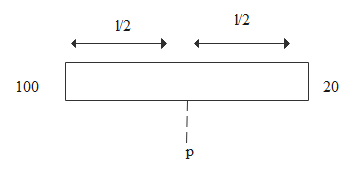
The temperature of hot and cold end of a 20 cm long rod in thermal steady state are at ${{100}^{{}^\circ }}C$ and ${{20}^{{}^\circ }}C$ respectively. Temperature at the centre of the rod is:
(A) ${{50}^{{}^\circ }}C$
(B) ${{60}^{{}^\circ }}C$
(C) ${{40}^{{}^\circ }}C$
(D) ${{30}^{{}^\circ }}C$
Answer
118.8k+ views
Hint: We know that the measure of the ability of a substance, or more generally of any physical system, to transfer heat energy to another physical system. The temperature of a substance is closely related to the average kinetic energy of its molecules. Celsius is currently a derived unit for temperature in the SI system, kelvin being the base unit. ${{0}^{{}^\circ }}C$ The two main reference points of the Celsius scale were the freezing point of water (or melting point of ice) being defined as ${{0}^{{}^\circ }}C$ and the boiling point of water being ${{100}^{{}^\circ }}C$.
Complete step by step solution:
Let us start the answer by the diagram for this question:

Now we have to form the expression from the values that are mentioned in the given question:
Let us first write that:
${{H}_{1}}+{{H}_{2}}=0$
Now we have to form the equation involving the temperature variables:
$\dfrac{\Delta {{T}_{1}}}{{{R}_{1}}}+\dfrac{\Delta {{T}_{2}}}{{{R}_{2}}}$
Now after the evaluation we get that:
$\dfrac{\Delta {{T}_{1}}}{{{R}_{1}}}+\dfrac{\Delta {{T}_{2}}}{{{R}_{2}}}=0$
$\Rightarrow \dfrac{T-20}{{{R}_{1}}}+\dfrac{T-100}{{{R}_{2}}}=0$
$\Rightarrow T-20+T-100=0$
So, the final temperature is given as
$T=\dfrac{120}{2}=60$
Hence, the temperature at the centre of the rod is ${{60}^{{}^\circ }}C$.
So, the correct answer is option B.
Note: We know that the human body reacts to external and internal changes. Body temperature rises when the external temperature increases but also when the internal temperature increases. When temperatures rise, the body reacts by increasing blood flow to the skin's surface, taking the heat from within the body to the surface. This means sweat. As the sweat evaporates, the body cools down.
It should be known to us that when our body temperature drops, our heart, nervous system and other organs can't work normally. Left untreated, hypothermia can lead to complete failure of our heart and respiratory system and eventually to death. Hypothermia is often caused by exposure to cold weather or immersion in cold water.
Complete step by step solution:
Let us start the answer by the diagram for this question:

Now we have to form the expression from the values that are mentioned in the given question:
Let us first write that:
${{H}_{1}}+{{H}_{2}}=0$
Now we have to form the equation involving the temperature variables:
$\dfrac{\Delta {{T}_{1}}}{{{R}_{1}}}+\dfrac{\Delta {{T}_{2}}}{{{R}_{2}}}$
Now after the evaluation we get that:
$\dfrac{\Delta {{T}_{1}}}{{{R}_{1}}}+\dfrac{\Delta {{T}_{2}}}{{{R}_{2}}}=0$
$\Rightarrow \dfrac{T-20}{{{R}_{1}}}+\dfrac{T-100}{{{R}_{2}}}=0$
$\Rightarrow T-20+T-100=0$
So, the final temperature is given as
$T=\dfrac{120}{2}=60$
Hence, the temperature at the centre of the rod is ${{60}^{{}^\circ }}C$.
So, the correct answer is option B.
Note: We know that the human body reacts to external and internal changes. Body temperature rises when the external temperature increases but also when the internal temperature increases. When temperatures rise, the body reacts by increasing blood flow to the skin's surface, taking the heat from within the body to the surface. This means sweat. As the sweat evaporates, the body cools down.
It should be known to us that when our body temperature drops, our heart, nervous system and other organs can't work normally. Left untreated, hypothermia can lead to complete failure of our heart and respiratory system and eventually to death. Hypothermia is often caused by exposure to cold weather or immersion in cold water.
Recently Updated Pages
JEE Main 2025: Application Form, Exam Dates, Eligibility, and More

NTA JEE Mains 2025 Correction window - Dates and Procedure

A steel rail of length 5m and area of cross section class 11 physics JEE_Main

At which height is gravity zero class 11 physics JEE_Main

A nucleus of mass m + Delta m is at rest and decays class 11 physics JEE_MAIN

A wave is travelling along a string At an instant the class 11 physics JEE_Main

Trending doubts
Free Radical Substitution Mechanism of Alkanes for JEE Main 2025

Electron Gain Enthalpy and Electron Affinity for JEE

Collision - Important Concepts and Tips for JEE

JEE Main Chemistry Exam Pattern 2025

The diagram given shows how the net interaction force class 11 physics JEE_Main

An Lshaped glass tube is just immersed in flowing water class 11 physics JEE_Main

Other Pages
NCERT Solutions for Class 11 Physics Chapter 4 Laws of Motion

NCERT Solutions for Class 11 Physics Chapter 3 Motion In A Plane

NCERT Solutions for Class 11 Physics Chapter 13 Oscillations

Find the current in wire AB class 11 physics JEE_Main

JEE Main 2023 January 25 Shift 1 Question Paper with Answer Keys & Solutions

Thermodynamics Class 11 Notes CBSE Physics Chapter 11 (Free PDF Download)




